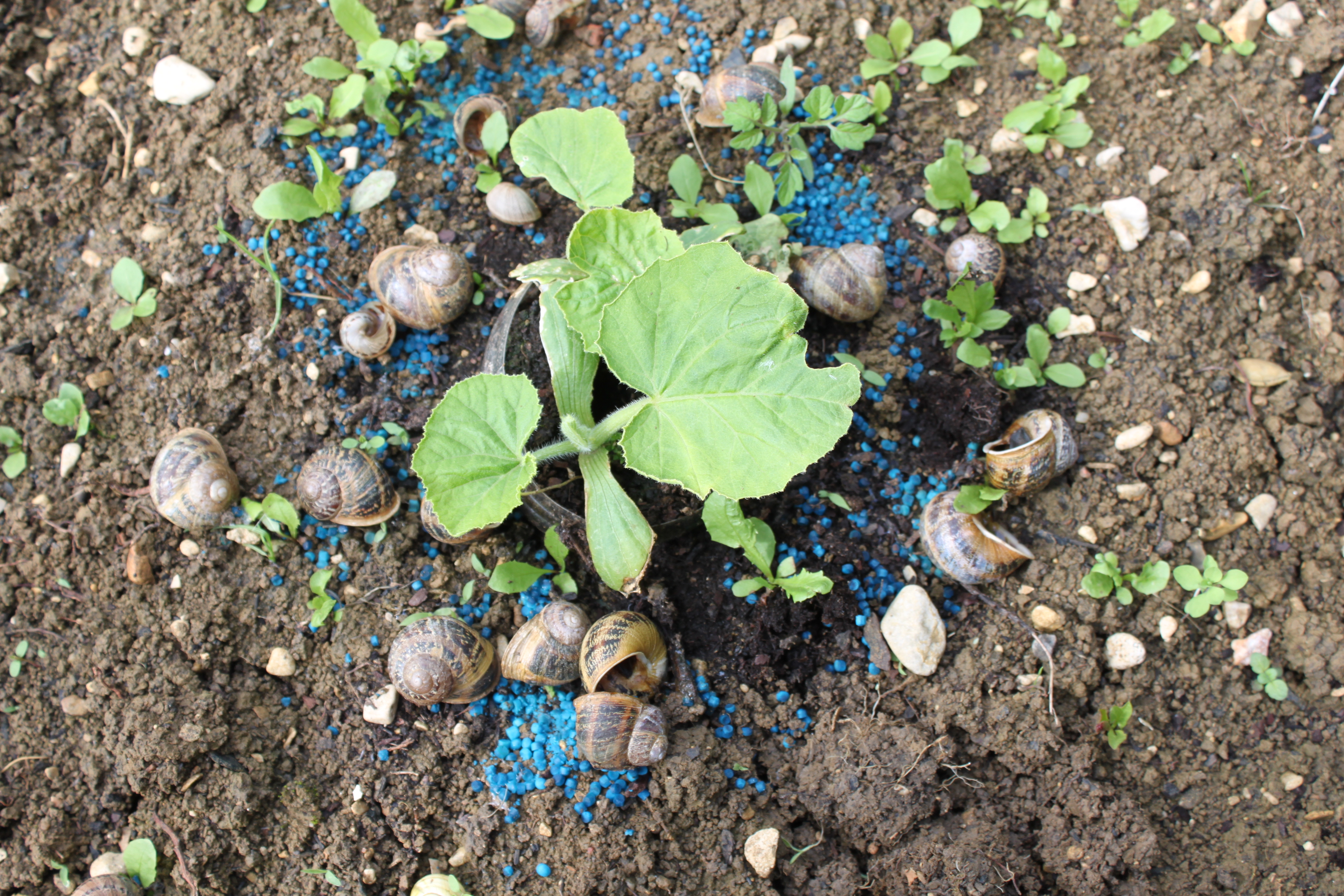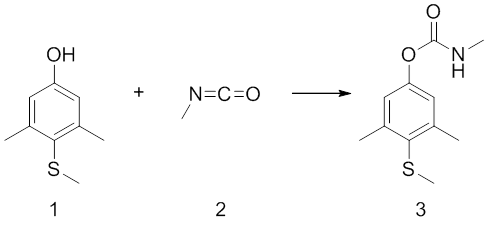|
Molluscicide
Molluscicides () – also known as snail baits, snail pellets, or slug pellets – are pesticides against molluscs, which are usually used in agriculture or gardening, in order to control gastropod pests specifically slugs and snails which damage crops or other valued plants by feeding on them. A number of chemicals can be employed as a molluscicide: * Metal salts such as iron(III) phosphate, aluminium sulfate, and ferric sodium EDTA, relatively non-toxic, also used in organic gardening * Metaldehyde * Niclosamide * Acetylcholinesterase inhibitors (e.g. methiocarb), highly toxic to other animals and humans, acts also as a contact poison Accidental poisonings Metal salt-based molluscicides are not toxic to higher animals. However, metaldehyde-based and especially acetylcholinesterase inhibitor-based products are highly toxic, and have resulted in many deaths of pets and humans. Some products contain a bittering agent that reduces but does not eliminate the risk of accidental ... [...More Info...] [...Related Items...] OR: [Wikipedia] [Google] [Baidu] |
Methiocarb
Methiocarb is a carbamate pesticide (an acetylecholinesterase inhibitor) which is used as an insecticide, bird repellent, acaricide and molluscicide since the 1960s. Methiocarb has contact and stomach action on mites and neurotoxic effects on molluscs. Seeds treated with methiocarb also affect birds. Other names for methiocarb are mesurol and mercaptodimethur. Due to its toxicity, methiocarb approval as a plant protection product has been withdrawn by the EU effective 2020. Structure and reactivity The carbamate functional group in methiocarb can be cleaved by cholinesterase to result in the carbamate, which binds to the cholinesterase, and the aromatic alcohol. Synthesis Methiocarb (3) is synthesised by Bayer from 4-methylthio-3,5-xylenol (1) and methyl isocyanate (2). The xylenol (1) will act as the nucleophile in this reaction attacking the partially positively charged carbon in the isocyanate (2). Mechanism of action Methiocarb acts by acetylcholinesterase inhibition ... [...More Info...] [...Related Items...] OR: [Wikipedia] [Google] [Baidu] |
Aluminium Sulfate
Aluminium sulfate is a salt with the chemical formula, formula aluminium, Al2sulfate, (SO4)3. It is soluble in water and is mainly used as a Coagulation (water treatment), coagulating agent (promoting particle collision by neutralizing charge) in the purification of drinking water and wastewater treatment plants, and also in paper manufacturing. The anhydrous form occurs naturally as a rare mineral millosevichite, found for example in volcanic environments and on burning coal-mining waste dumps. Aluminium sulfate is rarely, if ever, encountered as the anhydrous salt. It forms a number of different hydrates, of which the hexadecahydrate Al2(SO4)3·16H2O and octadecahydrate Al2(SO4)3·18H2O are the most common. The heptadecahydrate, whose formula can be written as [Al(H2O)6]2(SO4)3·5H2O, occurs naturally as the mineral alunogen. Aluminium sulfate is sometimes called alum or papermaker's alum in certain industries. However, the name "alum" is more commonly and properly used for any ... [...More Info...] [...Related Items...] OR: [Wikipedia] [Google] [Baidu] |
Metaldehyde
Metaldehyde is an organic compound with the chemical formula, formula (C8H16O4). It is used as a pesticide against slugs, snails, and other gastropods. It is the cyclic tetramer of acetaldehyde. Production and properties Metaldehyde is flammable, toxic if ingested in large quantities, and irritating to the skin and eyes. It has a white crystalline appearance with a menthol odor. Metaldehyde is obtained in moderate yields by treatment of acetaldehyde with various Acid catalysis, acid catalysts, such as hydrogen bromide, and cooling. The liquid trimer, paraldehyde is also obtained. The reaction is reversible; upon heating to about 80 °C, metaldehyde and paraldehyde revert to acetaldehyde. Metaldehyde exists as a mixture of four stereoisomers, molecules that differ with respect to the relative orientation of the methyl groups on the 8-membered ring. The stereoisomers have respectively the molecular symmetries C (with symmetry of order 2), C (order 4), D (order 8), and C ( ... [...More Info...] [...Related Items...] OR: [Wikipedia] [Google] [Baidu] |
Metaldehyde
Metaldehyde is an organic compound with the chemical formula, formula (C8H16O4). It is used as a pesticide against slugs, snails, and other gastropods. It is the cyclic tetramer of acetaldehyde. Production and properties Metaldehyde is flammable, toxic if ingested in large quantities, and irritating to the skin and eyes. It has a white crystalline appearance with a menthol odor. Metaldehyde is obtained in moderate yields by treatment of acetaldehyde with various Acid catalysis, acid catalysts, such as hydrogen bromide, and cooling. The liquid trimer, paraldehyde is also obtained. The reaction is reversible; upon heating to about 80 °C, metaldehyde and paraldehyde revert to acetaldehyde. Metaldehyde exists as a mixture of four stereoisomers, molecules that differ with respect to the relative orientation of the methyl groups on the 8-membered ring. The stereoisomers have respectively the molecular symmetries C (with symmetry of order 2), C (order 4), D (order 8), and C ( ... [...More Info...] [...Related Items...] OR: [Wikipedia] [Google] [Baidu] |
Pesticide
Pesticides are substances that are meant to control pests. This includes herbicide, insecticide, nematicide, molluscicide, piscicide, avicide, rodenticide, bactericide, insect repellent, animal repellent, microbicide, fungicide, and lampricide. The most common of these are herbicides which account for approximately 80% of all pesticide use. Most pesticides are intended to serve as plant protection products (also known as crop protection products), which in general, protect plants from weeds, fungi, or insects. As an example, the fungus ''Alternaria solani'' is used to combat the aquatic weed ''Salvinia''. In general, a pesticide is a chemical (such as carbamate) or biological agent (such as a virus, bacterium, or fungus) that deters, incapacitates, kills, or otherwise discourages pests. Target pests can include insects, plant pathogens, weeds, molluscs, birds, mammals, fish, nematodes (roundworms), and microbes that destroy property, cause nuisance, or spread disease, or a ... [...More Info...] [...Related Items...] OR: [Wikipedia] [Google] [Baidu] |
Ferric Sodium EDTA
Ferric sodium EDTA, also known as sodium ferric ethylenediaminetetraacetate, is a broad spectrum molluscicide used to kill snails and slugs and protect agricultural crops and garden plants, and in particular to eliminate infestations of ''Cornu aspersum'', the common garden snail. Chemically, it is a salt of ethylenediaminetetraacetic acid. Mechanism of action and environmental impacts Ferric sodium EDTA works by interacting with and destroying hemocyanin, a copper based compound found in the blood of molluscs and arthropods which is used to carry oxygen, similar to hemoglobin found in vertebrates, and typically kills snails and slugs in a matter of days following exposure. The compound is much safer than Metaldehyde Metaldehyde is an organic compound with the chemical formula, formula (C8H16O4). It is used as a pesticide against slugs, snails, and other gastropods. It is the cyclic tetramer of acetaldehyde. Production and properties Metaldehyde is flammable, ... and does n ... [...More Info...] [...Related Items...] OR: [Wikipedia] [Google] [Baidu] |
Iron(III) Phosphate
Iron(III) phosphate, also ferric phosphate, is the inorganic compound with the formula Fe PO4. Several related materials are known, including four polymorphs of FePO4 and two polymorphs of the dihydrate FePO4·(H2O)2. These materials find few technical applications as well as occurring in the mineral kingdom. Structure The most common form of FePO4 adopts the structure of α-quartz. As such the material consists of tetrahedral Fe(III) and phosphate sites. As such the P and Fe have tetrahedral molecular geometry. At high pressures, a phase change occurs to a more dense structure with octahedral Fe centres. Two orthorhombic structures and a monoclinic phase are also known. In the two polymorphs of the dihydrate, the Fe centre is octahedral with two mutually cis water ligands. Uses Iron(III) phosphate can be used in steel and metal manufacturing processes. When bonded to a metal surface, iron phosphate prevents further oxidation of the metal. Its presence is partially r ... [...More Info...] [...Related Items...] OR: [Wikipedia] [Google] [Baidu] |
Contact Poison
Poison is a chemical substance that has a detrimental effect to life. The term is used in a wide range of scientific fields and industries, where it is often specifically defined. It may also be applied colloquially or figuratively, with a broad sense. Whether something is considered a poison may change depending on the amount, the circumstances, and what living things are present. Poisoning could be accidental or deliberate, and if the cause can be identified there may be ways to neutralise the effects or minimise the symptoms. In biology, a poison is a chemical substance causing death, injury or harm to organisms or their parts. In medicine, poisons are a kind of toxin that are delivered passively, not actively. In industry the term may be negative, something to be removed to make a thing safe, or positive, an agent to limit unwanted pests. In ecological terms, poisons introduced into the environment can later cause unwanted effects elsewhere, or in other parts of the food ... [...More Info...] [...Related Items...] OR: [Wikipedia] [Google] [Baidu] |
Higher Animal
The evolution of biological complexity is one important outcome of the process of evolution. Evolution has produced some remarkably complex organisms – although the actual level of complexity is very hard to define or measure accurately in biology, with properties such as gene content, the number of cell types or morphology all proposed as possible metrics. Many biologists used to believe that evolution was progressive (orthogenesis) and had a direction that led towards so-called "higher organisms", despite a lack of evidence for this viewpoint. This idea of "progression" introduced the terms " high animals" and " low animals" in evolution. Many now regard this as misleading, with natural selection having no intrinsic direction and that organisms selected for either increased or decreased complexity in response to local environmental conditions. Although there has been an increase in the maximum level of complexity over the history of life, there has always been a large majority ... [...More Info...] [...Related Items...] OR: [Wikipedia] [Google] [Baidu] |
Acetylcholinesterase Inhibitor
Acetylcholinesterase inhibitors (AChEIs) also often called cholinesterase inhibitors, inhibit the enzyme acetylcholinesterase from breaking down the neurotransmitter acetylcholine into choline and acetate, thereby increasing both the level and duration of action of acetylcholine in the central nervous system, autonomic ganglia and neuromuscular junctions, which are rich in acetylcholine receptors. Acetylcholinesterase inhibitors are one of two types of cholinesterase inhibitors; the other being butyryl-cholinesterase inhibitors. Acetylcholinesterase is the primary member of the cholinesterase enzyme family. Acetylcholinesterase inhibitors are classified as reversible, irreversible, or quasi-irreversible (also called pseudo-irreversible). Mechanism of action Organophosphates Organophosphates like TEPP and sarin inhibit cholinesterases, enzymes that hydrolyze the neurotransmitter acetylcholine. The active centre of cholinesterases feature two important sites, namely the a ... [...More Info...] [...Related Items...] OR: [Wikipedia] [Google] [Baidu] |
Bitter (taste)
The gustatory system or sense of taste is the sensory system that is partially responsible for the perception of taste (flavor). Taste is the perception produced or stimulated when a substance in the mouth biochemistry, reacts chemically with taste receptor cells located on taste buds in the oral cavity, mostly on the tongue. Taste, along with olfaction and trigeminal nerve stimulation (registering texture, pain, and temperature), determines Flavoring, flavors of food and other substances. Humans have taste receptors on taste buds and other areas, including the upper surface of the tongue and the epiglottis. The gustatory cortex is responsible for the perception of taste. The tongue is covered with thousands of small bumps called lingual papillae, papillae, which are visible to the naked eye. Within each papilla are hundreds of taste buds. The exception to this is the filiform papillae that do not contain taste buds. There are between 2000 and 5000Boron, W.F., E.L. Boulpaep. 2003 ... [...More Info...] [...Related Items...] OR: [Wikipedia] [Google] [Baidu] |





